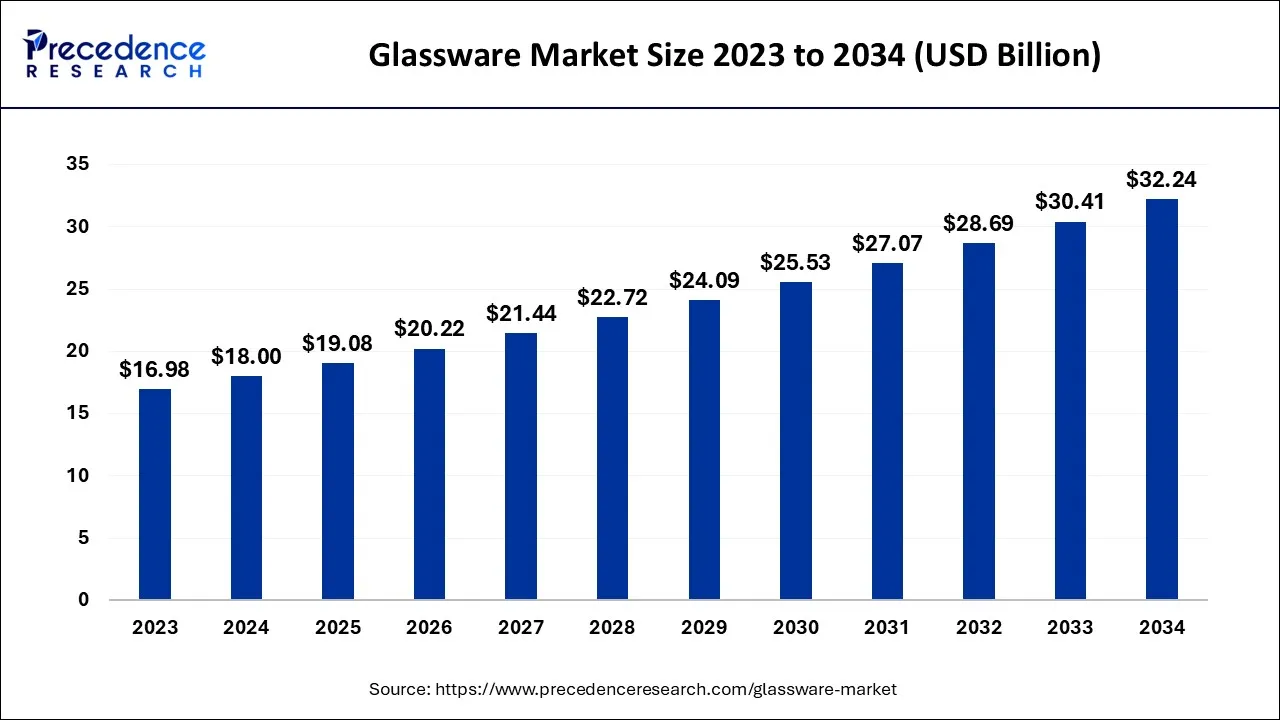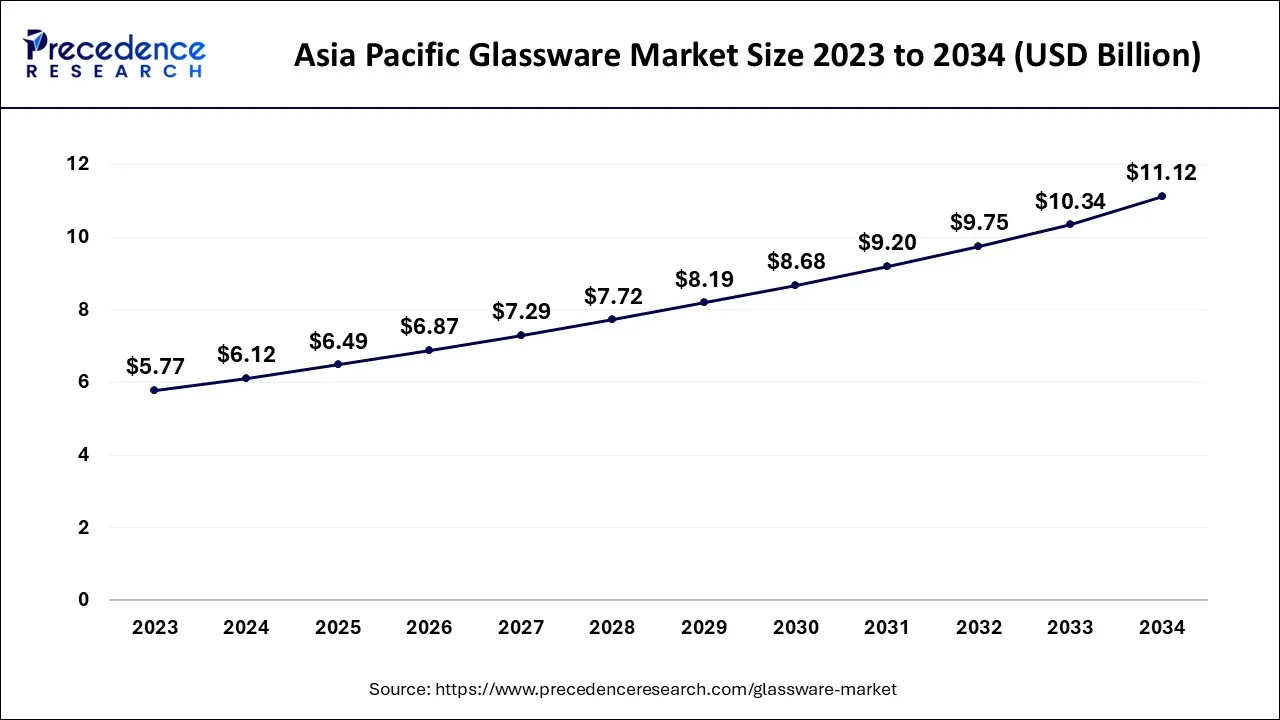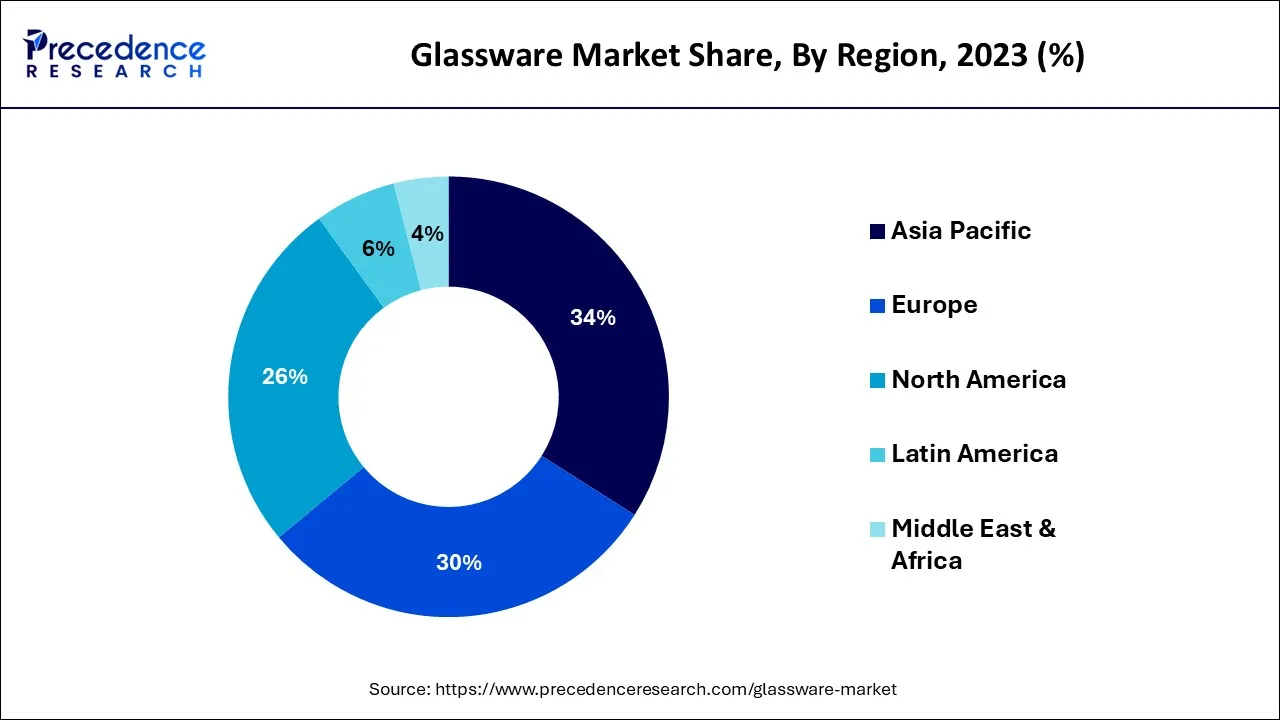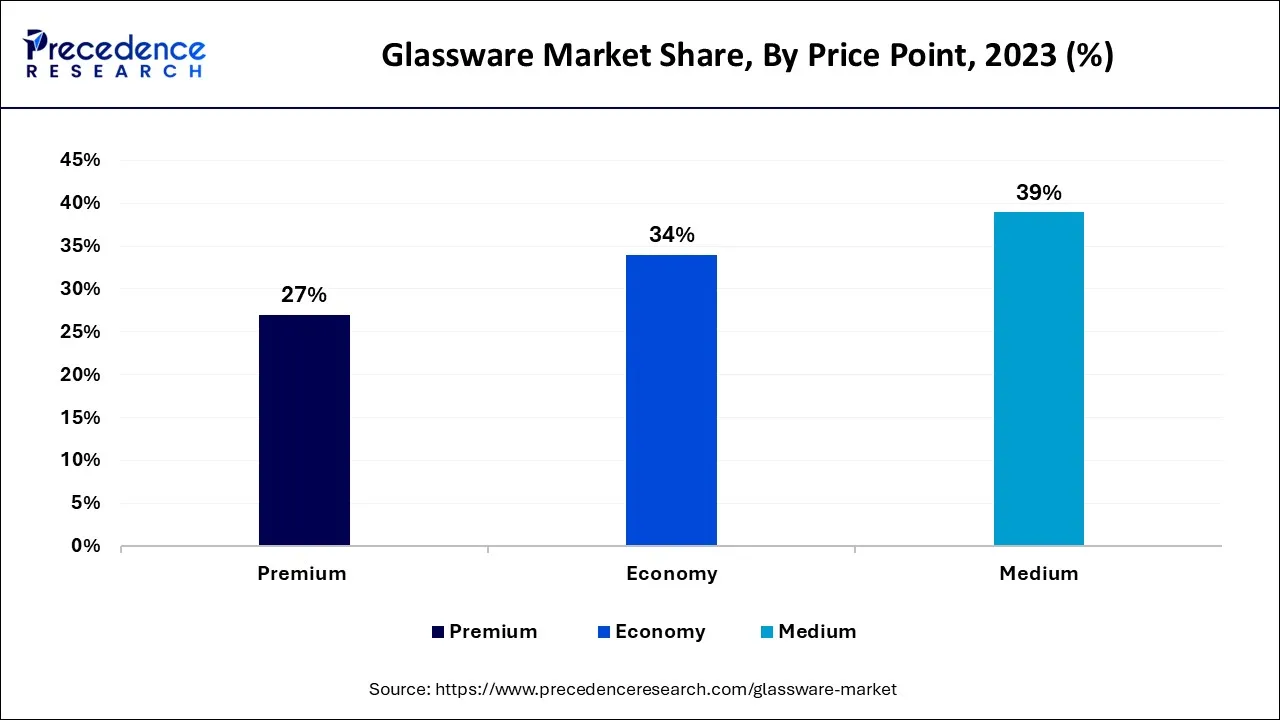The global glassware market size accounted for USD 18.00 billion in 2024, grew to USD 19.08 billion in 2025, and is expected to be worth around USD 32.24 billion by 2034, poised to grow at a CAGR of 6% between 2024 and 2034. The Asia Pacific glassware market size is predicted to increase from USD 6.12 billion in 2024 and is estimated to grow at the fastest CAGR of 6.16% during the forecast year.
The global glassware market size is expected to be valued at USD 18.00 billion in 2024 and is anticipated to reach around USD 32.24 billion by 2034, expanding at a CAGR of 6% over the forecast period from 2024 to 2034.

The Asia Pacific glassware market size is exhibited at USD 6.12 billion in 2024 and is projected to beglassware market worth around USD 11.12 billion by 2034, growing at a CAGR of 6.16% from 2024 to 2034.

The Asia Pacific is expected to hold the largest market share over the forecast period. The growth in the region is attributed to increasing urbanization, especially in the countries like China and India. For instance, 461 million people are living in urban areas in India. This figure is increasing by 2.3% yearly. According to estimates, cities would generate 75% of India's national income by 2031. Moreover, the growing number of restaurants and bars in the region is expected to propel the growth of the market over the forecast period. India has seen a rise in the number of fine dining establishments, cafes, pubs, bars, clubs, lounges, and international fast-food restaurants in recent years as a result of the changing eating preference of the millennial generation. The age group known as Generation Y, or those between 18 and 35, makes up around 65% of the population in India. They are well-educated, internet savvy, frequently exposed to global trends and lifestyles, well-travelled, and wealthy. Thus, the growing food service industry is expected to fuel the glassware industry during the forecast period.

Europe is expected to capture a significant revenue share in 2023 and is expected to continue the same pattern over the forecast period. The region expanding hospitality industry is increasing demand for fine glassware. The popularity of Filipino restaurants around the nation is expanding the market for fine glassware products. For instance, Jollibee, a global network of 4,300 Filipino restaurants launched its flagship location in the United Kingdom in December 2018 and has the plan to open 25 more locations there over the projected year. Thus, this is expected to rise the product demand in the region during the study timeframe.
North America is expected to hold a substantial market share during the forecast period. The growth in the region is changing consumer eating habits and the fast penetration of the restaurant industry especially in Canada and the United States. For instance, according to the National Restaurants Association, the US restaurant industry accounted for USD 833 billion and is expected to reach USD 1.2 trillion by 2030. Moreover, the growing penetration of online service restaurants is expected to offer enormous opportunities for market expansion over the forecast period.
The glass is an inorganic, transparent, stiff, non-crystalline, and adaptable substance consisting of a mixture of metal oxides that have been fused at high temperatures. Three crucial characteristics of glassware, including transparency, stability and inertness, and malleability, are well known across the globe. Over the projected period, it is anticipated that the growth of the residential and commercial sectors, rising disposable income and shifting lifestyle would boost product demand. The expansion of the market is influenced by the expanding business sectors, particularly the hospitality sector. Furthermore, growing urbanization, increasing restaurants and pub cultures, and the growing tourism sector are all influencing market expansion over the forecast period.
According to the United Nations Conference on Trade and Development (UNCTAD), in 2011, 52.0% of the population resided in an urban area while in 2021, 56.5% lived in urban areas. In general, it will be higher in developed nations (79.5%) than in developing ones (51.8%) in 2021.
According to the most recent UNWTO World Tourism Barometer, international tourist arrivals nearly quadrupled (+172%) from January to July 2022 compared to the same period in 2021. This means that the sector has recovered over 60% of its pre-pandemic levels. The gradual recovery reflects substantial pent-up demand for international travel as well as the current loosening or removal of travel restrictions (86 nations have no COVID-19-related limitations as of September 19, 2022).
| Report Coverage | Details |
| Market Size in 2024 | USD 16.9 Billion |
| Market Size by 2034 | USD 28.55 Billion |
| Growth Rate from 2024 to 2034 | CAGR of 6% |
| Largest Market | Asia Pacific |
| Base Year | 2023 |
| Forecast Period | 2024 to 2034 |
| Segments Covered | Material, Product, Price Point, Distribution Channel, End User, and Region |
| Regions Covered | North America, Europe, Asia-Pacific, Latin America, and Middle East & Africa |
Growing investment in the hotel and catering industry
Tourism has boosted hotel and restaurant businesses all around the world and opened up new opportunities for the hospitality industry. Tourism has fueled the industry's growth, as have distinct landscapes, faiths, and lifestyles in many countries, which have drawn tourists from all over the world. Many nations' hotel and catering sectors have gradually increased over the last two decades, and growth is expected in the next years, along with an increase in demand for various types of glassware goods.
Fragile and moldy nature of glass
Glass tableware has the problem of being easily broken. When used incorrectly, it has the potential to produce an explosion. The glass tableware is sanitary and does not contain any hazardous elements. However, if the glass tableware is not cleaned for an extended period, it will grow moldy. Thus, this is expected to hamper the market growth over the forecast period.
Availability of cheap products
Glass is one of the most complicated and flexible materials, used in almost every sector. The significant use of glass adds to both residential and commercial structures having a very hi-tech and modern aspect. Glass is available in a wide range of forms and sizes to fit a wide range of purposes and is utilized in a wide range of architectural applications such as doors, windows, and partitions. Glass has progressed from its humble beginnings as a windowpane to its current status as a sophisticated structural component.
Based on the material, the global glassware market is segmented into soda lime glass, crystal glass, borosilicate glass and heat-resistant glass. The soda lime glass segment is expected to grow at the highest CAGR during the forecast period. 90% of all manufactured glass is soda lime glass, making it the most produced form of glass. It is a basic mixture of silica, soda and lime that has been produced for hundreds of years and has a range of beneficial features for uses across a variety of industries, including the manufacturing of consumer goods, packaging and scientific fields.
Moreover, the inexpensive nature of soda lime glass is expected to drive segment growth over the forecast period. On the other hand, heat-resistant glass is expected to hold the largest market share over the forecast period. A frequent component of heat-resistant glass is soda lime, which has a very low expansion coefficient and a high melting point, or silica. A form of glass made to withstand thermal stress is called heat-resistant glass. This glass is thought to be superior to all other common glasses that are currently available. Typically, this kind of glass is employed in industrial settings and kitchens. It has been demonstrated to be capable of withstanding temperature swings of up to 1000 degrees Celsius, or 1,832 degrees Fahrenheit. Thus, this property is expected to propel the segment's growth.
Based on the product, the global glassware market is divided into coffee mugs, wine glasses, normal glasses, spirit glasses, beer mugs, pitchers, tea cups, glass jars and others. The glass jars segment is expected to dominate the market during the forecast period. Food and drinks are frequently stored in glass jars. The materials used to make glass jars, crystal and soda lime glass, give them strength. In the food service business, glass jars are frequently used to serve and preserve beverages while also preventing them from contamination. Besides, the beer mug segment is expected to grow at the fastest rate during the forecast period.
The growth in the segment is attributed to the growing bar culture across the globe. Besides, the wine glass segment is expected to capture the largest market share during the forecast period. This is due to an increasing number of individuals in different regions becoming acclimated to drinking various varieties of wine, which is positively boosting wine glass sales. Europe has some of the most established wine markets in the world, with nations such as Portugal, Italy, and France having the highest per capita annual consumption of more than 35 liters. Eastern European wine sales were more than three times higher in April 2018 than in 2017. The preceding condition contributes to the rising demand for wine glasses.
Based on the price point, the global glassware market is divided into premium, medium and economy. The medium segment is expected to dominate the market during the forecast period.

The market for mid-range glassware includes a variety of glass products because most consumers like products in this price range that are high quality and less expensive. Thus, this is expected to drive the growth of this segment.
Based on the distribution channel, the global glassware market is divided into hypermarkets and supermarkets, specialized stores, online retail and others. The specialized store segment is expected to dominate the market during the forecast period. This is attributable to consumers who, especially in upscale restaurants and hotels, are predicted to seek out more speciality, distinctive products for their tables. Consumers today prefer glassware that is distinctive and a greater representation of their way of life.
They choose niche boutiques as a result since standard retail outlets may not always carry these goods. Speciality shops are becoming more and more popular because they offer a wide variety of products with distinctive qualities, like a funny graphic or exquisite motif, and they provide trend-driven glassware that may go above and beyond what customers expect. In the upcoming years, these components are anticipated to accelerate segment expansion. On the other hand, the online retail segment is expected to grow substantially over the forecast period. This is due to technological improvements and a growing tendency for purchasing glassware products through online platforms, which provide convenience from product selection to delivery.
Segments Covered in the Report
By Material
By Product
By Price Point
By Distribution Channel
By End User
By Geography
For inquiries regarding discounts, bulk purchases, or customization requests, please contact us at sales@precedenceresearch.com
No cookie-cutter, only authentic analysis – take the 1st step to become a Precedence Research client